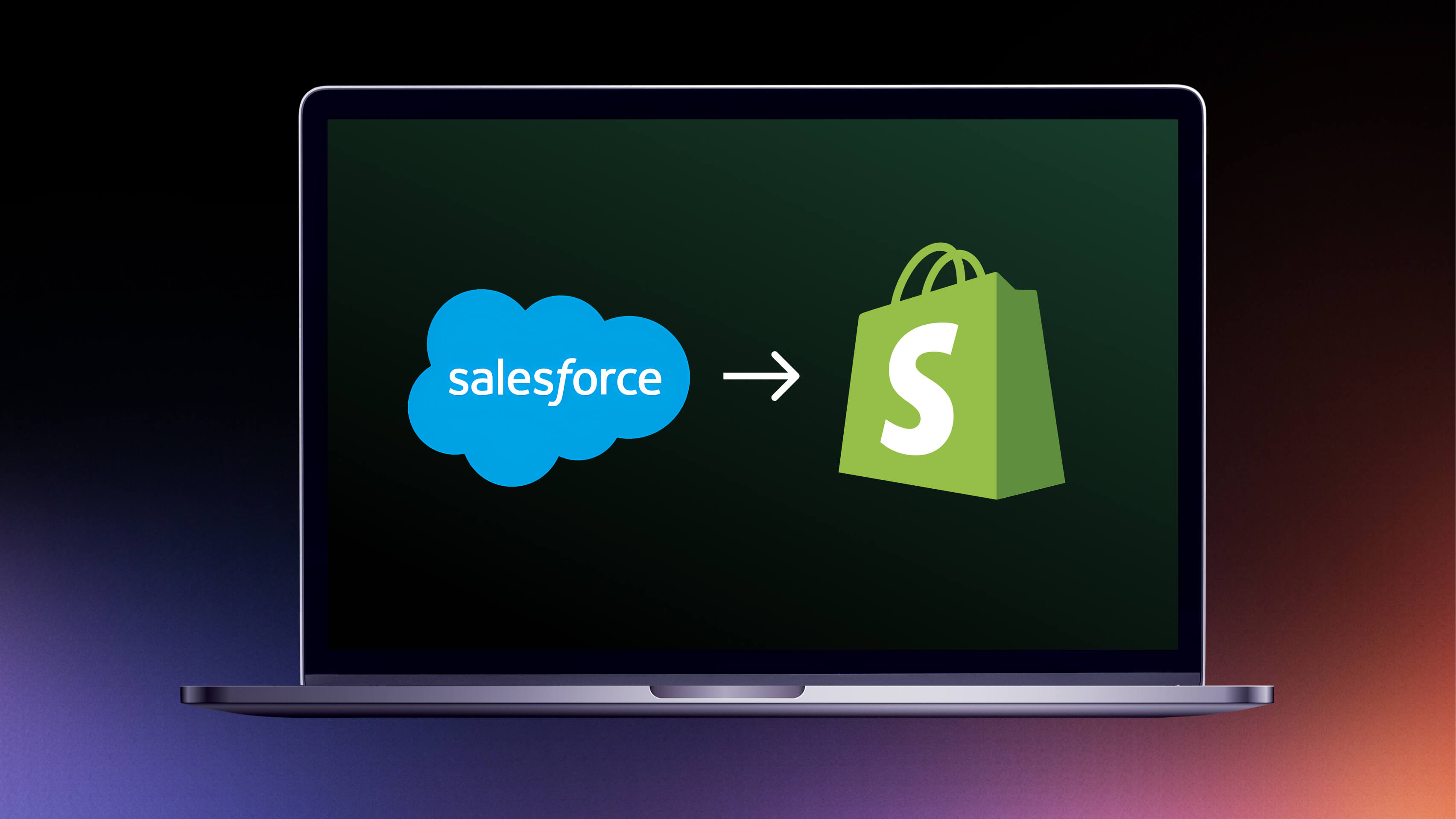Case Study: Every Man Jack
Every Man Jack used a modern cart flyout to save two months of dev work and help boost AOV by over 10%.

Migrating from Salesforce to Shopify? This guide helps you plan, execute, and optimize your move while boosting performance and personalization.
Migrating from Salesforce Commerce Cloud (SFCC) to Shopify is a strategic decision for ecommerce businesses looking for greater flexibility, lower costs, and enhanced ecommerce performance.
While Salesforce Commerce Cloud offers powerful features, many businesses find it complex and expensive to maintain. Shopify provides a more intuitive, scalable, and cost-effective solution with built-in features and extensive third-party integrations.
In this comprehensive guide, we’ll take you through each step of the migration process, ensuring a smooth transition, data integrity, and continued business growth on Shopify.
Table of Contents
Don't get lost in the migration from Salesforce to Shopify. Connect with our Partnerships Team to be matched with your ideal migration partner.
Many businesses switch from Salesforce Commerce Cloud to Shopify due to cost efficiency, usability, and scalability. However, Shopify’s AI-driven personalization tools, such as Rebuy Engine, provide a unique advantage by enabling businesses to increase customer engagement and maximize revenue through intelligent upselling and cross-selling.
Salesforce Commerce Cloud comes with high licensing fees, complex development costs, and ongoing maintenance expenses. Shopify eliminates many of these expenses with its fully hosted infrastructure and transparent pricing plans.
Salesforce Commerce Cloud requires extensive technical expertise for customization and maintenance. Shopify’s intuitive interface allows business owners, marketers, and sales teams to manage their store with minimal IT involvement.
Shopify Plus is designed to handle high-volume transactions, bulk ordering, and customer-specific pricing, making it an ideal solution for fast-growing ecommerce brands.
Brands are moving from SFCC to Shopify for faster ROI, lower overhead, and the agility to grow on their terms. The payoff is real. Less operational toil, more time driving revenue. With partners like Rebuy, retailers boost AOV and retention from day one, making the value of migrating clear and compelling.

Shopify’s cloud-based hosting infrastructure ensures fast page speeds, optimized checkout experiences, and enterprise-grade security, helping businesses meet compliance requirements without additional hosting costs.
Shopify’s vast app ecosystem provides pre-built integrations for ERP systems, CRM software, inventory management, and marketing automation, enabling businesses to quickly enhance their ecommerce capabilities.
One of Shopify’s most powerful advantages is its ability to enhance customer experience and drive revenue with AI-powered personalization tools like Rebuy Engine.
Rebuy Engine enables Shopify merchants to:
By switching from Salesforce Commerce Cloud to Shopify, businesses can leverage a more intuitive and cost-effective ecommerce solution while unlocking the power of AI-driven personalization through Rebuy Engine. This transition helps brands boost conversions, improve customer retention, and create a smarter, data-driven ecommerce strategy.
A successful migration requires buy-in from key stakeholders and a clear roadmap. Before proceeding, outline the business case for migration to ensure alignment across departments.
Key Stakeholders to Involve:
Key ROI Considerations:
Proper preparation is essential for a smooth and efficient migration from Salesforce Commerce Cloud to Shopify. By taking proactive steps, businesses can ensure that data is accurately transferred, minimize downtime, and preserve SEO rankings.
Key Pre-Migration Steps:
By carefully preparing for migration, businesses can reduce potential data loss, SEO disruptions, and operational downtime, ensuring a seamless transition to Shopify.
When migrating from Salesforce Commerce Cloud to Shopify, it’s essential to consider how your personalization strategy will evolve on a new platform. The table below offers a side-by-side comparison of Salesforce Einstein and Rebuy Engine to help you evaluate which solution aligns best with your business goals, tech stack, and go-to-market speed.
Comparing personalization platforms? See how Salesforce Einstein and Rebuy stack up across key features to help you make an informed migration decision.
Selecting the right Shopify plan is essential for aligning with your business needs and ensuring cost efficiency. Shopify offers multiple plans tailored to different business sizes and operational complexities:
When choosing a plan, consider current sales volume, business growth projections, and necessary integrations to ensure you select a tier that aligns with your operational needs.
💡 For enterprises requiring advanced pricing controls, automation, and large-scale wholesale capabilities, Shopify Plus is the best investment.
By selecting the right Shopify plan, businesses can ensure their ecommerce operations are efficient, scalable, and ready for continued growth.
“We've seen firsthand how much some of our clients feel locked down and limited with unnecessarily complex system architectures before transitioning to Shopify. Often, these clients require costly customizations and significant reliance on developers to connect their most essential systems or build a more comprehensive experience. By migrating from these platforms to a truly plug-and-play, customizable system with a rich ecosystem, our clients can scale more rapidly, resulting in a significant reduction in their total cost of ownership.”

Exporting data from Salesforce Commerce Cloud is a crucial step in the migration process, ensuring that all key business information is accurately transferred to Shopify. This includes products, customer accounts, order history, tax configurations, and custom data fields.
By carefully exporting and organizing your data, businesses can prevent data loss, migration errors, and customer experience disruptions when moving to Shopify.
Once your data has been successfully exported from Salesforce Commerce Cloud, the next step is importing it into Shopify. Ensuring that your product listings, customer accounts, and order history are correctly formatted and mapped is crucial for a seamless transition.
Shopify offers two main ways to import data:
By following structured import steps and using the right migration tools, businesses can ensure a successful transition to Shopify while maintaining data accuracy and operational efficiency.
Once your data is imported into Shopify, the next step is to rebuild your storefront to align with your brand and provide an optimal ecommerce customer experience. This involves selecting the right theme, organizing product categories, and configuring checkout functionality for bulk buyers.
By carefully rebuilding your storefront with ecommerce functionality in mind, you create an intuitive, conversion-optimized shopping experience that meets the needs of your wholesale and enterprise customers.
After migrating your data and storefront structure, it’s time to elevate your customer experience. For DTC brands, this means enabling your loyalty, membership programs, and mobile-first commerce integrations.
This step is about building a smarter, faster, and more connected shopping journey that drives lifetime value and boosts customer satisfaction.
Connect your Shopify store to loyalty providers like Okendo and Yotpo to showcase customer reviews, referrals, and point-based incentives.
These platforms integrate directly with Rebuy, allowing loyalty status and rewards data to surface dynamically in Rebuy Smart Cart, personalized product recommendations, and post-purchase offers.
📚 Related reading: Increase Customer Loyalty & Retention with these 5 Post-Purchase Tips
🔗 Explore integrations → Loyalty partners
Mobile-first is no longer optional. It’s table stakes. Integrate Rebuy with mobile commerce platforms like Tapcart and Fuego to deliver on-brand, app-native experiences with personalized product feeds, AI-powered cart upsells, and frictionless reordering.
With Rebuy's plug-and-play integration, you can extend personalization beyond the browser and into the palms of your most loyal customers.
🔗 Explore integrations → Mobile App partners
If you're using page builders like Shogun or Builder.io to create dynamic landing pages or campaign experiences, Rebuy integrates seamlessly, allowing product recommendations, bundles, and upsells to appear wherever your brand needs them.
Pair beautiful, fast-loading custom storefronts with intelligent merchandising logic. No code required.
🔗 Explore integrations → Visual Builders
Want to reward your best customers with more than points? Integrate with platforms like Inveterate to offer VIP perks, member-only discounts, or cashback benefits. Then, display those values within Rebuy’s Smart Cart and product experiences.
🔗 Explore integrations → Inveterate
Pro Tip: Shopify’s open ecosystem is a DTC superpower. By combining Shopify’s core capabilities with Rebuy and best-in-class apps, you can design a shopping experience that’s fast, personalized, and primed for growth.
Up next: Payments, taxes, and shipping.
Absolute Web has guided hundreds of brands through seamless replatforming. From data integrity to storefront customization, their team ensures your migration is fast, secure, and built to scale.
To ensure seamless ecommerce transactions, businesses must configure payment gateways, tax calculations, and shipping rules that align with their operational needs. Shopify provides flexible payment options, automated tax calculations, and customizable shipping rules to support bulk orders and international B2B transactions.
By setting up Shopify Payments, tax compliance, and shipping logistics, businesses can ensure a smooth and efficient ecommerce purchasing experience, reducing manual work and enhancing operational efficiency.
A well-planned SEO strategy is critical during migration to prevent loss of rankings, traffic drops, and broken links. By implementing 301 redirects, updating metadata, and optimizing site structure, businesses can ensure a smooth transition for search engines and users.
By following these SEO best practices, businesses can retain organic traffic, maintain search rankings, and provide a seamless transition for customers post-migration.
When migrating from Salesforce Commerce Cloud to Shopify, mid-market and enterprise brands need to ensure that their new storefront isn’t just functional—but optimized for conversion, retention, and AOV growth. That’s why we recommend installing Rebuy as part of your migration from Salesforce Commerce Cloud to Shopify.
Shopify stores using Rebuy can significantly increase revenue and enhance the shopping experience using AI-powered product recommendations, smart site search, a customizable shopping cart, and more. Explore the Rebuy platform →
Rebuy’s suite of AI-powered omnichannel personalization tools helps brands unlock Shopify’s full potential, replacing Salesforce Commerce Cloud’s complex, custom-built solutions with agile, no-code, and low-code merchandising. Here’s why installing Rebuy should be a priority during your migration:
Rebuy stands as a Premier Shopify Partner and a Shopify Plus Certified App, delivering enterprise-level security and full SOC 2 compliance for your migration projects. Trusted by Shopify for its innovation and performance, Rebuy collaborates closely with leading migration agencies—including Absolute Web, Domaine, and Teifi Digital—to ensure a seamless, secure, and efficient transition from Salesforce Commerce Cloud to Shopify.
Salesforce Commerce Cloud stores often rely on custom-coded personalization that’s difficult to scale. Rebuy’s AI-powered product recommendations dynamically adjust to shopper behavior across homepages, product pages, carts, checkout, post-purchase experiences, and more.
Salesforce Commerce Cloud stores typically require custom scripts or extensions for upsells and cross-sells. Rebuy makes it effortless with AI-powered bundles, one-click upsells, and smart add-ons that increase AOV while reducing friction throughout the customer journey.
We’ve seen a significant rise in demand from brands and retailers migrating from Salesforce to Shopify, driven by a lower total cost of ownership (TCO), superior and constantly evolving trading tools, and Shopify’s state-of-the-art app ecosystem. Leading solution providers like Klaviyo and Rebuy empower merchants to focus on what matters most: growing their core business.

For brands migrating from Salesforce Commerce Cloud that rely on subscriptions, Rebuy integrates seamlessly the top subscription providers like Recharge, Skio, and Smartrr, allowing you to personalize subscription upsells and improve retention, all within Shopify’s app ecosystem.
Unlike Salesforce Commerce Cloud, Shopify Plus checkout limits customization—but Rebuy bridges the gap. With checkout page personalization, dynamic offers, and AI-driven upsells, Rebuy helps Shopify Plus merchants maximize last-minute conversions without needing custom development.
Migrating to Shopify isn’t just about moving products—it’s about optimizing how they’re sold. Rebuy’s real-time analytics and A/B testing empower brands to track performance, optimize recommendations, and continuously refine merchandising strategies—offering more agility than Salesforce Commerce Cloud’s rule-based systems.
Migrating from Salesforce Commerce Cloud to Shopify offers a great opportunity to optimize your entire ecommerce tech stack. (See how SpearmintLOVE did it). Rebuy is one of the most deeply integrated Shopify apps, offering plug-and-play connections with industry leaders like:
Rebuy even offers its own Rebuy App Store, allowing brands to enhance their Smart Cart with additional cart-enhancing integrations. Instead of struggling with Salesforce Commerce Cloud’s custom development challenges, Shopify merchants can leverage Rebuy’s unified ecosystem to create a seamless, high-converting shopping experience.
So, don’t just migrate. Elevate your customer experience with Rebuy’s AI-powered personalization tools. From smart recommendations to checkout upsells, Rebuy helps brands sell smarter, convert faster, and accelerate revenue growth.
🚀 Want to see Rebuy in action before making a decision? Request a demo of Rebuy today.
🚀 Ready to personalize your new Shopify store now? Follow these easy steps to install Rebuy and set up your first Rebuy-powered product recommendations today.
Before making your Shopify store live, conducting thorough pre-launch testing is essential to ensure a seamless customer experience and error-free operations. This step helps identify and fix potential issues before rolling out the store to all users.
✅ Test Product Pages, Checkout, and Customer Login.
Verify that all product listings, pricing, descriptions, and inventory levels are correct. Ensure that the checkout process functions smoothly and that customers can log in and access their account details without issues.
✅ Ensure Bulk Pricing & Discounts Are Correctly Applied.
Check that wholesale pricing tiers, volume discounts, and customer-specific pricing rules are correctly configured and applied during checkout.
✅ Test Order Processing, Invoices, and Automated Workflows.
Simulate placing, processing, and fulfilling orders to confirm that invoices are generated correctly, order confirmations are sent, and automated workflows (e.g., tax calculations, shipping rules) function as expected.
✅ Implement Fraud Protection & Security Checks.
Enable Shopify’s built-in fraud detection tools and set up security protocols to safeguard transactions, prevent chargebacks, and protect customer data.
✅ Run a Soft Launch for Select Clients.
Before going live, invite a small group of trusted customers to test the store, provide feedback, and identify any usability issues. This allows you to make final adjustments before launching to a broader audience.
By following this comprehensive pre-launch checklist, ecommerce businesses can minimize risks, ensure a smooth customer experience, and successfully transition to Shopify’s robust ecommerce platform.
Once all pre-launch tasks are completed, it’s time to execute a final audit and officially launch your Shopify store. Ensuring a smooth transition for customers and internal teams is crucial to success.
✅ Verify Store Functionality.
Double-check that all product pages, pricing tiers, tax settings, and payment gateways function correctly.
✅ Test Order Processing.
Run test transactions to confirm that orders, invoices, and fulfillment processes are working as expected.
✅ Review Site Performance.
Use tools like Google PageSpeed Insights and Shopify’s built-in analytics to ensure fast load times and mobile responsiveness.
✅ Send Password Reset Emails.
Since Shopify cannot migrate encrypted passwords from Salesforce Commerce Cloud, send password reset notifications to existing customers.
✅ Inform Customers of New Features.
Use email marketing to highlight new improvements, enhanced navigation, and bulk ordering options available on the new Shopify store.
✅ Educate Staff on Shopify’s Backend.
Train sales, support, and fulfillment teams on order management, customer accounts, and reporting tools.
✅ Ensure Customer Support Readiness.
Equip teams with FAQs and troubleshooting guides to handle common customer concerns post-migration.
✅ Track Traffic & Sales Metrics.
Use Shopify Analytics and Google Analytics to monitor website traffic, conversion rates, and sales trends.
✅ Optimize Checkout Conversion Rates.
Analyze abandonment rates and run A/B tests on checkout flow to improve buyer experience.
✅ Address Issues Promptly.
Regularly check error reports, customer feedback, and order fulfillment efficiency, making adjustments as needed.
By executing a structured launch strategy, businesses can ensure a seamless transition to Shopify, maximizing sales potential and improving customer satisfaction.
Your ecommerce personalization journey starts here👇
Migrating to Shopify is just the beginning. To maximize sales, efficiency, and long-term growth, businesses must continuously optimize and refine their ecommerce operations.
By implementing these post-migration strategies, businesses can enhance customer engagement, increase revenue, and scale operations effectively in the competitive ecommerce space.
Shopify stands out for its ease of use, full cost transparency, and frictionless access to best-in-class apps. Large and enterprise-level merchants consistently praise the modern look and feel of well-executed Shopify storefronts, along with the flexibility to make front-end and content updates on the fly without heavy development cycles.

While migrating from Salesforce Commerce Cloud to Shopify can significantly improve efficiency, some common challenges may arise. Addressing these issues quickly ensures a seamless transition with minimal disruptions.
By proactively addressing these common migration challenges, businesses can maintain SEO rankings, data integrity, and customer satisfaction, ensuring a successful transition to Shopify.
Migrating from Salesforce Commerce Cloud to Shopify is a strategic move that can streamline operations, reduce costs, and enhance the overall buying experience. Shopify offers a scalable, user-friendly, and feature-rich platform that supports bulk ordering, customer-specific pricing, and automation—ensuring businesses can scale efficiently.
For businesses with complex requirements, working with Shopify Plus Experts or certified development agencies can ensure a fully optimized and customized store. From custom app development to advanced integrations, expert guidance can help maximize your Shopify store’s potential.
🚀 Ready to scale your ecommerce business on Shopify? Connect with our Partnerships team to get matched with the ideal migration partner and unlock a data-driven approach to Shopify success.
•••
Try Rebuy free and see why the world’s top brands use Rebuy to accelerate sales growth.
Interested in partnering with Rebuy? Let's do it.
To keep up with the latest trends, platform updates, and more, follow us on LinkedIn.
Migrating from Magento to Shopify? This step-by-step guide helps you plan, execute, and optimize your move while boosting performance and...
Improve UX, convert more traffic, and boost AOV with Rebuy Smart Cart, the intelligent all-in-one shopping cart.
Learn how to create memorable post-purchase experiences for your ecommerce store and why doing so is good for business. Perfect for Shopify.
Stay up to date with all things Rebuy by signing up for our newsletter.
